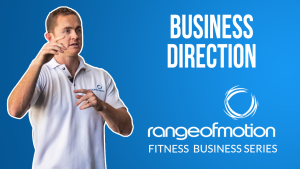1. Direction, Range of Motion Fitness Business Series
 With all the complexity that can come from the running of a fitness business, without direction, any efforts will be aimless.
With all the complexity that can come from the running of a fitness business, without direction, any efforts will be aimless.
The first step in developing a fitness business must be in identifying the vision for the business – the final (or at least long-term) destination.
With the long term vision identified, every operation of the business can then be reverse engineered to reach this endpoint.
A clearly desired outcome can also assist with decision making. When faced with options and choices within a business, the question can be asked, ‘which choice or decision will most likely contribute to the desired end result’. More often than not, this clear definition of the long-term plan for the business will make the correct decision obvious.
When visualising the long-term plan for a business, it’s important to consider business size (which can emphasise the importance of systems to allow future scaling), operations, the core product, and an exit strategy (whether this means selling the business, or outsourcing lower value roles).
With Range of Motion Business Mentoring clients, ultimately, the long-term vision we’re creating for the business in ‘owner-centric’, based around the impact the business will have on the business owner(s). Because in the end, a business should exist to support a desired lifestyle. In too many cases, the opposite is true (a lifestyle is designed to support a business), and the long-term sustainability of the business is jeopardised.
So by identifying the desired lifestyle of the business owner(s)/operator(s), the long-term vision of the business can be created to allow this lifestyle.
Once the destination has been established, and before we can identify the steps to undertake to get there, we must also identify the current state of the business – the financials, the successes/failures, the services offered. A clear picture of the business today.
With a departure point (the business today) and a destination (the business in the future), we can then begin the process of identifying the processes that must be taken to arrive at this future vision.
To bridge the gap between the present and the future, a structured goal setting process should be followed.
The first step in this process has already been completed, though it may need some refining. The first step is identifying the ‘outcome goals’ for the business, which is effectively the future vision we’ve already established. The refinement comes in ensuring these outcome goals meet certain criteria.
The goals should be specific, with a clear picture of exactly what the outcome is we’re chasing. Not only will this specificity help us establish the processes we need to get there, but when we do arrive at the destination, we’ll know.
We need to be able to measure the goal, not only so we know when it’s been completed, but also to gauge progress on the journey between present and future.
The goal should be action oriented, that is, achieving the goal should be based on our own actions. Relying on forces outside our control reduces our ability to create the business we desire.
The goal should be realistic – though moderately difficult. Research tells us that goals that are too easy, or too difficult are seldom achieved. We tend to reduce our effort levels for goals that are too difficult, as we don’t genuinely believe we can complete them. In the long run, this leads us down a slippery slope where we consistently set goals we don’t achieve, conditioning our minds to believe we’re the sort of person for whom goals don’t work – thus making future goal setting ineffective. By the same token, if the goals are too easy, we feel we’ll achieve them even without effort – the result being that we don’t try and fail even at these ‘easy’ goals. Ultimately, we should stretch ourselves, while still ensuring the goals are realistic.
Finally, the goals should be time-based. Parkinson’s Law tells us that the amount of time it takes to complete a task expands to fill the amount of time we have available to complete that task. It’s the same with goals. Without a self-imposed endpoint or ‘deadline’ there’s no urgency in the process and, in most cases, we never end up arriving at our desired destination.
Once we’ve established the outcome goals we’re chasing, we can work our way backwards to establish the actions we need to take to arrive there. These are the process goals – the actual practical steps we need to take to achieve the outcome goals.
For each outcome-based goal, we should identify a series of process goals (or action steps). These may be one-time actions, or (more commonly) recurring behaviours (habits) that we should systemise and either automate (preferred) or set up as a recurring schedule. By following this process, we end up with the practical steps we should be taking on a day-to-day basis. By following these steps, we’re undertaking the most important behaviours and actions that will lead us towards our outcome goals and intended final destination.




